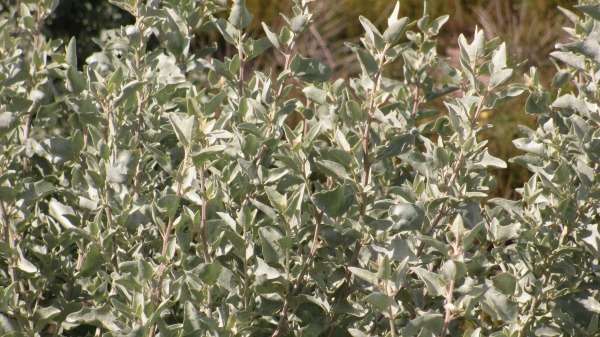Rehabilitation plant unmasked as common saltbush

Scientists investigating the genetic status of the land rehabilitation and fodder plant eyres green saltbush (Chenopodioideae) have revealed that it is in fact the common shrub old man saltbush (Atriplex nummularia).
Eyres green saltbush is cloned cultivar that is widely used across agricultural WA but, until now, its origins had remained a mystery.
In a move to help farmers decide which saltbush species is best to rehabilitate their land the study into the cultivar's genetics confirmed its connection to old man saltbush and that it was probably derived from the subspecies found in eastern Australia (ssp. nummularia) rather than the one found mostly in WA (ssp. spathulata).
Department of Parks and Wildlife researcher Dr Jane Sampson says the information will prove beneficial for landowners.
"Oldman saltbush is planted extensively for forage and landscape rehabilitation on salt-affected agricultural lands as it is well adapted to drought and tolerates high soil salinity," Dr Sampson says.
"For Western Australian landowners, knowing that eyres green is from eastern Australia is important.
"Having information about where the eyres green cultivar comes from helps in making informed decisions about plantings and enables assessment of risk of contaminating local saltbush plants with foreign genetic material."
Planting saltbush presents little immediate risk
Dr Sampson says planting this species in WA has little immediate risk of pollinating the local subspecies because A. nummularia is a dioecious species with separate male and female plants and eyres green is a female cultivar—it doesn't produce pollen.
However, in the long term, it could mix with local subspecies if plantings occur within pollination distance of a natural source of the species and establishes male plants that could subsequently pollinate natural populations.
To determine eyres green cultivar's subspecies, Dr Sampson and her colleagues examined genetic markers in collections across Australia.
They used DNA markers and statistics that measure patterns of genetic similarities and differences.
The task's difficulty was exacerbated because of the plant's polyploid nature, meaning it has multiple copies of chromosomes to be considered.
Dr Sampson says the species' evolution is very complex and has probably included crossing between different species.
Despite the difficulties, the genetic analysis clearly showed the clone known as eyres green saltbush to be from the ssp. nummularia of old man saltbush, confirming the value of this species in rehabilitation of salt-affected land.
Provided by Science Network WA
















